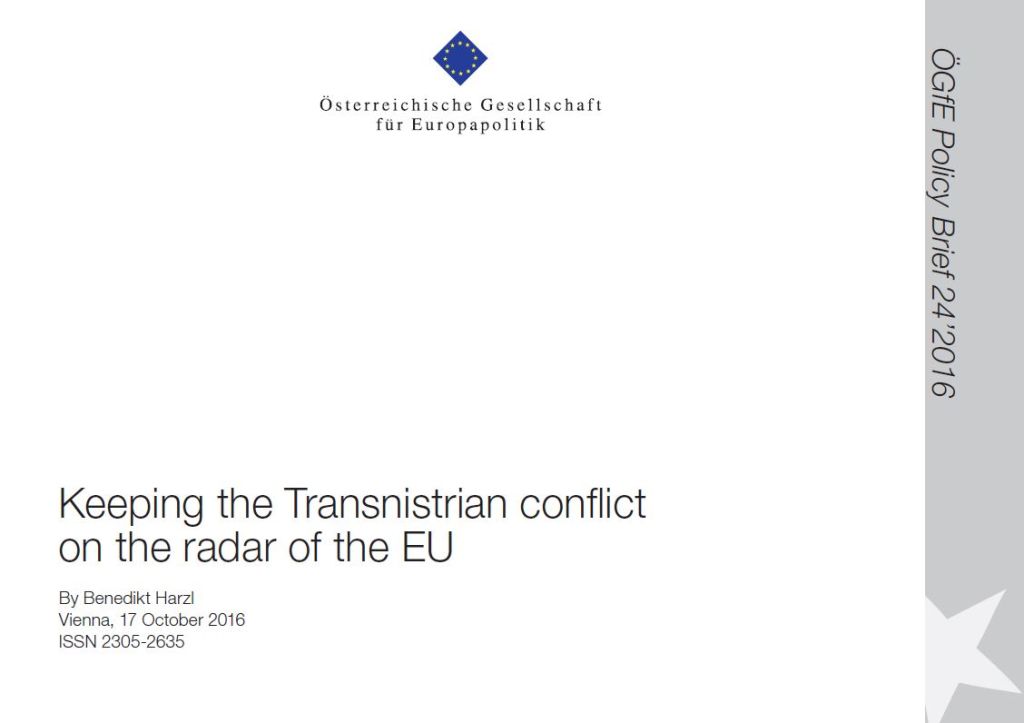Policy Recommendations
- The EU must remain committed to rule of law reforms in Moldova and should make use of the various instruments provided by the Association Agreement, in order to address the root causes of the conflict.
- The EU must keep the vision of a possible settlement of the Transnistrian conflict on its political agenda and should also continue to reach out to Transnistrian authorities on an informal level.
- The Austrian government should treat the 2017 OSCE chairmanship as a window of opportunity to reinforce both the necessary dialogue with Russia as well as constructive discussions over Transnistria.
Abstract
Even if the long-standing jam log over Transnistria will not create a situation in which a relapse to an armed conflict seems likely, the EU must ensure to maintain engagement with the conflict parties. As the ongoing conflict in Donbas keeps siphoning off and the Euroscepticism grows in Moldova itself, the danger that Transnistria disappears from the political agenda is very high. Such a scenario could result in the whole region gradually drifting off into a space of disorder and lawlessness, thereby planting the seeds of future instability. The EU must, therefore, take full advantage of the instruments provided in the Association Agreement in order to tackle rule of law issues and to address the Transnistrian problem in a long-term perspective. This policy brief will, hence, review this frozen protracted conflict in a wider substantive and regional context, and conclude with some policy recommendations for the EU.
****************************
Keeping the Transnistrian conflict on the radar of the EU
Mapping the problem
On 30 August 2016, the European Court of Human Rights again brought the issue of the unresolved crisis over the break-away entity Transnistria to the awareness of policy makers in Europe. In the judgement, in which the Strasbourg Court essentially confirmed its past case law relating to the circumstances under which Article 1 of the European Convention on Human Rights is applicable,[1] the Russian Federation was found liable for unlawful interference with the property rights of two Moldovan citizens who were fined by Transnistrian de facto authorities for refusing to place Transnsitrian number plates on their cars during transit through this self-proclaimed republic. Even if we ignore the failure of the Court to differentiate between jurisdiction and responsibility,[2] this case serves as an important but painful reminder that a resolution in a conflict over a tiny disputed region at the doorsteps of the EU remains a distant vision. Making things even worse, this “frozen” conflict is simultaneously aggravated and overlooked due to the drama in adjacent Ukraine, in addition to experiencing a growing popular frustration with the EU in Moldova. At present, it remains to be seen how these two variables will impact the progress in the conflict over Transnistria and what the nature of this impact is going to be. In any case, EU decision-makers should be aware of this potential interplay and must keep the unresolved conflict over Transnistria high on the political agenda.
Weak institutions and EU fatigue
As if Moldova’s contested statehood problem were not enough of a burden, the country is also occupied with its own ‘home-grown’ problems that are piling up to a huge heap. The perpetual coming and going of government coalitions with pro-Western labels and, most importantly, the Moldovan bank fraud – not without exaggeration described as ‘theft of the century’[3] – in which even the past pro-Western beacon of hope, former Prime Minister Vlad Filat, appears to be involved, have once again left the country on the edge of a serious crisis. Not only has this damaged the EU’s image in the eyes of millions of Moldovan citizens,[4] it has, moreover, bluntly illustrated the manifest and systemic signs of the political instability in Moldova. Hence, the idea of eventually heading to a pro-Russian direction could find some approval in the population again, given the disillusionment with the pro-Western forces that have governed the country since 2009.
The idea of eventually heading to a pro-Russian direction could find some approval in the population again, given the disillusionment with the pro-Western forces that have governed the country since 2009.
Particularly on the eve of the first presidential elections since 1996, it sounds naïve to believe that Russia will not try drawing support from this widespread dissatisfaction. Moreover, these domestic troubles of the “right bank” can additionally serve as convenient excuse for both Moscow and Tiraspol to avoid pro-active engagement in the 5+2 talks over Transnistria or to raise the stakes. Yet, this current Moldovan self-absorption will at the same time trigger the question to which extent the Transnistrian conflict still remains on the political agenda of the country. Indeed, the seemingly low prioritization on creating a shared vision of how a possible power-sharing agreement could look like can no longer be concealed in the midst of these domestic upheavals. The EU must, therefore, continue to address rule of law issues in Moldova and engage in the fight against corruption in order to keep Transnistria on the agenda and to tackle root causes of instability in a long-term perspective.
Transnistria in troubles
However, the “left bank” is far from doing better, in particular in the economic field. The tremendous pre-2009 economic growth rates of up to 10 percent per annum[5] are definitely gone. Grinding poverty and a bleak economic outlook have also led to a brain drain of younger people to Russia, turning Transnistria into a “republic of pensioners and children”.[6] Dependent on remittances and facing a huge gas debt of about 4 bln USD to Gazprom, the Shevchuk regime was arguably ‘encouraged’ by Moscow to make some concessions to the EU. Since the EU-granted Autonomous Trade Preferences (ATP) for Transnistria were set to expire on 1st of January 2016, the Transnistrian authorities found themselves under increasing pressure to act.
Since the EU-granted Autonomous Trade Preferences (ATP) for Transnistria were set to expire on 1st of January 2016, the Transnistrian authorities found themselves under increasing pressure to act.
With about 30 to 40 percent of its exports destined for the EU, the removal of ATP would have amounted to an existential threat for the left bank. Therefore, Tiraspol was essentially compelled to grant certain concessions to the EU such as the standardization of the customs tariffs with Moldova or the gradual lifting of import duties in a deal reached with Chisinau in late 2015.[7] Only this informal agreement enabled the EU-Moldova association council to extend, in exchange for those concessions, the Deep and Comprehensive Free Trade Agreement (DCFTA) over the whole territory of Moldova, encompassing Transnistria as well. Despite the EU’s failure to find the suitable tools to monitor and review the implementation of these concessions, it must be ensured that this pathway of engaging with Transnistria continues. The dependency of Tiraspol on the EU as a major export area allows Brussels to treat Transnistria not as a geopolitical, but rather as a technical issue in which the EU can help by delivering what it does best: Focusing on removing trade barriers, introducing WTO standards and, in the long run, providing a positive transformation scenario, even in Transnistria.
Potential fallout: The crisis over Ukraine
Any further destabilization in adjacent Transnistria will affect conflict-ridden Ukraine as well.
Ukraine has always had a special position in this quagmire. Not only is it Moldova’s largest neighbor, but about 100,000 of Transnistrians inhabitants hold Ukrainian passports.[8] This allows them to look for jobs in Ukraine and indeed, the country has become a major recipient of Transnistrian migrant workers. Yet, at the same time, this linkage makes Ukraine potentially vulnerable. Any further destabilization in adjacent Transnistria will affect conflict-ridden Ukraine as well. Kiev is, hence, also member of the 5+2 negotiation format and has already sponsored settlement proposals such as the ‘Yushchenko plan’ in 2005. Since the beginning of the 1990s, Ukraine sought to pursue a cautious position, wary of balancing relations with both the West and Russia. This rather neutral stance was also necessary for the Russian 14th army in Transnistria, which could not have been supplied in any way other than through Ukrainian territory with the Ukrainian government’s consent.[9] After the Euromaidan and with the ongoing war in Donbas, this precarious balance, however, collapsed. For a long time, observers even feared a Russian-led stirring-up of sentiments in the Odessa region and the subsequent opening of a second front in Transnistria with Russian military advances into South and Southeastern regions of Ukraine. Had this been the Moscow-planned scenario, it has clearly failed.
The ongoing war in Donbas will also have a share in deciding the fate of Transnistria.
Nevertheless, the ongoing war in Donbas will also have a share in deciding the fate of Transnistria. As William Hill aptly noted, “Ukraine’s war with Russia virtually ensures that the political settlement talks will go nowhere”.[10] The primary objective of the EU must be, hence, to ensure that the conflict parties remain committed to the swift implementation of the Minsk accords. Stabilizing the situation in the Donbas region will help in reinforcing the talks on Transnistria.
What has to be done?
- The EU must maintain its focus on institutional capacity-building and address the rule of law problems in Moldova as a long-term objective. Particularly, it must prioritize the fight against endemic corruption, making full use of the Association Agreement in this context, eventually by involving OLAF.[11]
- The Council of the EU has already expressed concern about the lagging reform process.[12] Making use of negative conditionality and suspending financial assistance if no genuine legislative approximation and institutional reforms take place is one way for the EU to exert pressure on Moldova. Needless to say, this will not solve the Transnistrian conflict. But it can help remove those conditions of weak statehood that make and have made the country vulnerable to it.
- With no progress in the 5+2 talks, the EU must convey a vision of a settlement to the conflict parties. Not only will this contribute to put the Transnistrian topic on the agenda again, it could show that the EU is a problem-owner in its neighborhood. To this end, the Transnistrian authorities should also be given opportunities to be heard by the EU. The extension of the DCFTA to Transnistria was a positive, encouraging signal in this respect.
- Engagement with the Russian Federation remains inevitable – in the face of all. With EU-Russia relations at a historical low, the OSCE seems to be a more appropriate forum for limited exchange. To this end, the Austrian chairmanship in 2017 is well advised to put this and the Transnistrian conflict as a whole on its agenda.
- Even if the somewhat contradictory nature of the Minsk accords – in substance, nothing more than a ceasefire – does currently not allow ameliorating the Ukrainian crisis, the EU must further encourage the parties to comply with it. Only the implementation of Minsk will ensure a realistic chance of a genuine dialogue about peace and the conditions of power-sharing in Donbas and inject positive momentum to the 5+2 talks over Transnistria.
[1] This most crucial provision obliges member states within their jurisdiction to comply with the European Convention on Human Rights. With regard to Moldova, the European Court of Human Rights has established in its landmark decision Ilaşcu and Others v. Moldova and Russia that actions of Transnistrian authorities are directly attributable to Russian authorities.
[2] The case law of the ICJ would be a good source for this necessary distinction.
[3] Such a label is not out of proportions, given Moldova’s gross annual GDP of less than 7 bln USD. See: <http://www.worldbank.org/en/country/moldova/overview>.
[4] In the latest Public Barometer of Public Opinion, 45% of the population would like to see their country joining the EU, while a relative majority of 48% advocate for Moldova’s accession to the Russian-dominated Customs Union. See: <http://www.ipp.md/public/files/Barometru/Brosura_BOP_11.2015_first_part_ENGLISH_V1.pdf>.
[5] Reliable economic figures of de facto states are difficult to establish. But this estimation appears to be correct, see: DG External Policies of the EU, The Transnistrian issue: Moving beyond the status-quo, 2012, p. 14.
[6] See Karina Lungu’s sobering article “Transnistria: From entropy to exodus” <http://www.ecfr.eu/article/essay_transnistria_from_entropy_to_exodus>.
[7] In an agreement with Moldova, the conditions of this deal are still not fully disclosed to the public.
[8] See: <http://www.moldova.org/en/transnistria-number-of-ukrainian-and-russian-passports-growing-rapidly-206221-eng/>.
[9] These agreements on Russian-Ukrainian military cooperation were scrapped by the Ukrainian parliament in May 2015, see: <http://bigstory.ap.org/article/baf19656bef2402e826f3c321f6f9233/ukraine-lawmakers-suspend-military-cooperation-russia>.
[10] William Hill, Is Moldova Headed East? (Kennan Cable, No. 8, June 2015).
[11] Art. 425 of the AA provides for an involvement of the European Anti-Fraud Agency.
[12] See Council conclusions of February 2015: <http://www.consilium.europa.eu/en/press/press-releases/2016/02/15-fac-moldova-conclusions/>
ISSN 2305-2635
The views expressed in this publication are those of the author and not necessarily those of the Austrian Society of European Politics or the organisation for which the author works.
This work was supported by the Austrian Marshall Plan Foundation.
Citation
Harzl, B. (2016). Keeping the Transnistrian conflict on the radar of the EU. Vienna. ÖGfE Policy Brief, 24’2016







